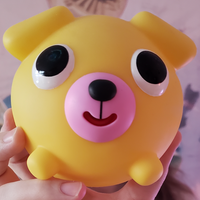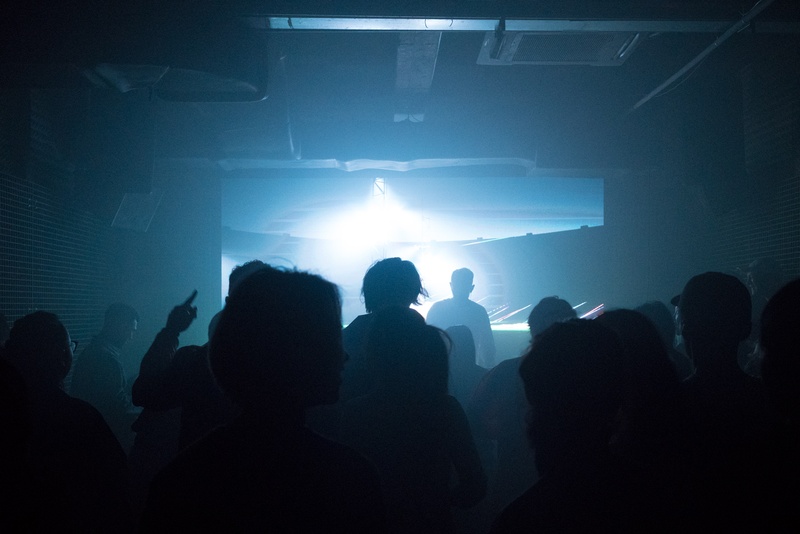As told to Julian Brimmers, 3580 words.
Tags: Art, Design, Process, Beginnings, Inspiration, Production.
On technology, social media, and working in 3D
Artist and designer Kim Laughton on living and working in Shanghai, navigating the digital realm, and the complications of working with clients.When did you first come to China, and what were you planning to do there?
When I came to China around 2009, I was taking photos. I never really planned to stay in China but it just happened. That was when the economy was just awful and the idea of being able to get a job in London seemed really difficult. I would have had to live in the middle of nowhere, basically, so I came here to do a project and stayed.
How did you find work in China? Or did you have to create it for yourself?
For the first few years I was doing these commercial VJ-type jobs. A lot of the stuff was really terrible and didn’t pay well either. Around 2012 I got really excited about Tumblr. People seemed to be using Facebook for more interesting stuff. You could find people and get to know the person, as well as what they were making.
Back then I started working on making clothes as Timefly. All this art I found on social media looked so amazing and it seemed interesting to make clothing using people’s work. Instead of just putting it on a t-shirt, which seemed a bit boring, I was trying to mimic the look of a fabric simulation falling over a body. We picked a fabric that draped really well and made this poncho-shape, almost as if it was a square of an image from the internet draped over people. That was the beginning. It probably was around 2014-2015 or so, where I could just do what I wanted to do, rather than doing the commercial VJ stuff.
Since you brought it up: there’s a lot of talk about how every person now is involved with self-branding and self-promotion through social media. On the other hand, artists who use it can’t only promote their work—there has to be a bit of personality attached to it as well. The divide between the personal and promotional vanishes in all directions.
Right, but at least before Instagram, when the interesting stuff was happening on Facebook, it didn’t feel like everyone was using it in a very crafted way. It was much more a platform for people to talk to friends, except those were friends you didn’t actually know in reality. And then they were posting their work too, so you could see somebody’s work and immediately chat to them, which was quite interesting. Now that doesn’t seem to happen that much. Facebook changed all its algorithms so it doesn’t really show anything anymore. I sound like a grandfather ranting about the good old days, but when all social media was newer, there was less aggression. People were less restrained, so you got a much more personal impression instead of this very safe, curated thing that we’re completely familiar with now.
Which of these platforms do you find the most useful for you as an artist?
Tumblr was the most interesting when it was new. You could spend hours looking through everybody’s stuff. It also felt much more like a conversation. You had to do certain stuff, like, use the PNGs with the transparent background, so that when someone else posted it, everything blended in with the background on their Tumblr and their own weird themes. That was really exciting. It felt like you were responding to what somebody else was doing and vice versa.
Now it doesn’t seem that any platforms are particularly interesting. Instagram is the one I use most, because it’s the most casual and the one with the least amount of text. It’s also the one people here in China use the most. I don’t know, are there any that you like using?
Like is a strong word… Twitter is mildly fascinating in an essentially cruel way, I guess.
That’s why I never got into it. It seems that the very sharp points with a lot of vile got mixed in with everything else; it’s hard to sift apart. And it rewards you for having the sharpest response to whatever it is. All these things seem to be evolving people in directions they didn’t intend. Same with Youtube algorithms: it’s changing people’s behavior in fairly useless ways. It acts like it knows what you want in a way that you don’t even know yourself. It’s almost worrying clicking on something, because then Google will think you’re that kind of person and feed you that kind of shit.
There’s a weird pseudo-religious element to the idea of being afraid of Google quietly judging you for your online behavior.
{Laughs} True! Instagram, for example, knows how long you looked at the advert. If you linger too long, it will appear as if you’re into that thing.
As an expat, how did you go about connecting with the local scene in Shanghai?
In the beginning it didn’t really occur to me that anything like the stuff I’m seeing online would ever happen here, really. There was such a big gap between what was interesting in the rest of the world and what was happening here–it was a lot of indie rock or, if there was electronic stuff, it was old techno. Something that was past its peak in the rest of the world.
There were a few bookings but it was still foreigners in China booking people outside China. And then Chinese people started using VPNs more, and more people moved to Shanghai. People got used to connecting to the rest of the world and it all got interesting very quickly. All of a sudden there was a local demand for what I was doing, too. Maybe in some ways it doesn’t matter where the people who like your stuff are based, but somehow it’s nicer if it is in the same area. It’s a much more high-bandwidth interaction if you’re in the same room. When you’re doing visuals for music, you’re doing it for people in the same space. Hey, when you write an article, isn’t there always a disconnect because you’re not sitting in the same room with the people who are reading it, generally?
That’s true. You’re making visuals for people to collectively experience it. Whereas writing is mostly made for the very singular experience of one reader.
Yeah, but one thing about writing is that it can be a glue that joins small communities together. When it’s in a magazine that everyone from the community is reading, then there is a group response to it. I think that’s missing a bit now. There aren’t any new publications like DIS at the moment.
I wonder what came first, the dying of the magazines and the cultural platforms that nurture scenes, or the “everyone” in this analogy—are communities and subcultures just way too scattered for any unifying publication?
It’s a bit chicken and egg. Maybe at the time when DIS was doing what they were doing, it wasn’t necessarily a coherent subculture like punk and goth, where it’s mostly about how you dress, and what music you listen to. When DIS came along, it was already more about a certain way of thinking, which tied in with post-internet art and all that stuff. There was an understanding that the existing systems weren’t very suitable for what is happening now. There was definitely a kind of optimism about the future—which now seems a bit naive to have had in the first place. I’m sure there could be a new magazine or new thing that binds everything together today.
Why do you say that pro-futurist stance was naive to begin with?
No, no, I don’t think it felt naive THEN. But it almost feels naive to be optimistic about the future in general now. However, I think this is just a phase and we’re going to get back to being sick of this new emo, gloomy shit.
Back then, things were very optimistic, everyone was excited about what technology could let you achieve that you couldn’t previously. This has always happened in the past; for a while people are excited about the present. And then everybody gets jaded. Now it feels a little directionless. Looking back, there’s so much stuff that just feels like it happened 20 or 30 years ago, but spruced up with some slightly new wrapping paper. The scene we’re talking about felt really new, like something that couldn’t have existed before. It could only exist in a world where everybody was using the internet and the technology they could find to make stuff.
Many of the underlying ideas of those scenes born from the internet—things like vaporwave, or what PC Music were doing—seemed to be connected by the aesthetics of consumer goods and the acceleration of capitalism to a humorous extent. Extreme capitalism to gleefully showcase the apocalyptic effects of it.
Yes, the idea of it being humorous was very important. Everything was funny and didn’t take itself too seriously. There was no way to address these things very seriously anymore. Everything is so weird that using corporate elements in a serious way wouldn’t have worked. It wouldn’t have made the point it was making. It always had to be tongue in cheek.
Did you ever see yourself in a Cyberpunk tradition?
I don’t think so. Cyberpunk was also very pro-technology: looking at the way technology causes problems, but also worshipping it. It feels very different to me. The world in which you got the internet and everybody is using technology, it was imagining that. Once we actually had that world, then there was no point in fetishizing technology anymore. What we did was more about the subtle things, like the way people were talking about corporations. Cyberpunk imagined them as these big, super-evil conglomerates. Whereas now, corporations try to be your friend, which leads to a very different feeling. It’s hard to imagine a Facebook-type company in a Cyberpunk setting. It wouldn’t be cool enough.
Now, Cyberpunk is just as much of a fantasy as goblins. An alternate, slightly ’80s version of things that’s now locked forever. The reality is much more boring. 2019 didn’t come with endless rain and neon and people shooting each other, like Blade Runner promised. But we have the super advanced technology! Just instead of hacking into corporations to steal stuff and be cool characters, we use it to scroll through endless photos of breakfasts.
Speaking of endless scrolling—how do you deal with the maze of unread tabs that are open all the time?
I mean, I do use the same set-up for everything: work, research, leisure time. Going to work means getting out of bed and walking ten meters. But I do make sure I close all the tabs every few hours. Whenever it looks like there’s just too much mess, I close everything and start again. I guess it’s this weird feeling of the computer becoming an extension of your space. It gets messy, you clean it up and you feel the same kind of chemicals your brain is giving you for cleaning up your physical space. It gives you the same rewards for cleaning your computer.
There’s also this constant waiting for things to appear on your screen. You can be away from your laptop, but you’re still waiting for that ping. How do you handle that?
That can even go both ways: sometimes you want the response and sometimes you’re dreading it. All of that is such a big distraction. I mean requests like “can you do a cover for something,” then you gotta listen to it and often the music is not anything that you’d be remotely into. But how can you say no? Having to turn stuff down is really stressful. It shouldn’t be, but it is. You have to find a diplomatic way.
Like what?
The only thing is to say you’re busy—which is true! Even if you haven’t got a project that is taking up 100% of your time right at that moment, you’re still busy. Even if you’re taking a break for a couple of days. It is kind of honest. I haven’t really found any other way to turn someone down. I’ve done some things where I tried to politely say that I wasn’t really into it, but it feels hard to write, or insulting in a way. It’s hard to be honest with that kind of stuff.
How does that apply to working with corporate clients?
It’s similar, because you might want to work with them later. But they seem to be more used to it, because they operate in this non-personal way all the time. So it’s okay if you’re going into unpersonal mode, too. And if it’s not a very good request, you can just ignore it, if you’re not intending to work with them later. Sometimes, if a request is completely ridiculous, it can feel good to reply and say “I am not interested.” I had one really amazing one from a Swedish brand that is inspired by Japan in a super blatant way. They were asking for all these Japanese things to go in the video, sumo wrestlers and such. It was hilarious. That was the only one I turned down in a kind of sarcastic way.
You have a very distinctive style and technique. Do you ever feel typecast by clients?
That’s another really tricky thing. Everyone, just from talking to people and reading interviews, seems to have specific problems figuring out what a client wants. Often, they say in the beginning that they are open to whatever. And then, once you’ve already agreed to the job, a mood board will come over with a bunch of your old stuff. At that stage it is very hard to say you don’t want to do that anymore. That’s really difficult. You still need some direction to do what people want, of course.
Let’s talk a bit more about Shanghai. Oftentimes, the most creatively inspiring places can be terrible for artists in other respects. You already mentioned how finding a job in London would have been difficult. How does this balance of finding inspiration in a scene you feel connected to and the cost of living play out in Shanghai?
The cost of living is going up all the time. When I was first here, it was a lot cheaper. I had a lot of visa problems in the beginning so I had to leave every month or two to redo it, which was expensive and stressful. You never know whether you’re going to get a new one. It’s a really different city now. When you visit a new place, everything is inspiring. The place itself is interesting. After a few years, the place itself becomes familiar, so it is more about what individual things are happening there. When I got here, the city was amazing. Now I basically stay at home all the time and go out once or twice a week. Although there is much more going on with events now.
How would you describe the scene today?
For example, the Genome 6.66Mbp label, the stuff they’re doing is very connected with the rest of the world. They were booking people from everywhere but also had their own people that were making great stuff. It’s an extension of what people like Total Freedom were doing. All genres mixed together, but not in this mash-up way where it is about technical skill, showing the fact that you can mix something with something. It’s much more about the overall flow and the emotion of the whole thing you get. There are very few nights here where that one night has only one genre. If you just play a whole techno set, people are going to leave.
The visual aspect and the music seem to be part of the same experience in Shanghai.
That’s correct. I normally go to this club, All. One of the reasons Shanghai has gotten better is that there are many more clubs now than there used to be. The people who come to All, they do dress up in a way that seems cohesively linked with everything else going on. It feels like a scene of stuff happening, which it never did before. It’s probably quite rare around the world to have something that’s really all linked in that way. There could be a lot more done with visuals and decoration of the clubs, there is a lot more room there.
The idea of bringing digital art into the real-life spaces and even onto people, with your clothing—how difficult is that?
It’s actually quite easy. With 3D art you’re already starting with something that’s trying to represent something in the real word anyway. It’s using the real world’s coordinate system of making objects in a physical space. Which is different of course from other ways of being creative, making paintings or something like that. For the clothes, for example, I started with a Korean 3D program called Clo. You can design the clothing in there and then simulate them draping on people. You can see exactly what you’re gonna get.
At the beginning of last year, I did the design for All in Shanghai, and for another club, Oil, in Shenzhen. You’ve got to be a bit more detailed obviously with making up models and making sure they’re all to the right scale. Other than that, you’re still using the same process: you’re still looking at all the images and trying to find materials online and make 3D versions of everything, do tests. That’s a really useful thing about using 3D; it’s the basis for everything and anything physical. I haven’t got that much into 3D printing yet but I would like to.
And how about the other way around—how difficult is it to bring human physicality and movement into 3D renderings? Especially in your videos, you have worked with the human form more frequently.
Right, the stuff I have been doing recently has used people a lot more. I’m using the Unreal engine and most of the stuff I’ve been doing recently is running in real time, like a game. That’s a bit more forgiving because of the overall quality of the thing. There isn’t a need to make the humans look so perfect. I really like doing stuff with people and characters, it’s just quite difficult because there are so many elements that need to work well, the animation and all that stuff. Using motion capturing, for example, is something I’d like to do much more in the future.
So, if your whole professional, and a huge chunk of your private life, are happening online: how do you manage to not procrastinate so much on the internet? And if you do, how much inspiration do you get from it?
I used to get a lot more from the procrastination itself, when the content was more interesting. When Tumblr was newer and when there was more interesting stuff to be found, it didn’t feel so much like wasted time. So now, when I’m not doing anything useful, I try hard to do something that feels like you’re getting something out of it, like playing a video game, rather than just wasting time on social media, which is surely a drain for time.
Like we said in the beginning: this is a real thing that everybody’s trying to figure out how to deal with. All the companies who make social media try to make you keep looking at it. When everybody is just connected into mindless browsing, it’s draining so much creativity from humans, without leading to any deep emotion. It’s just treading water. A lot of people end up pissed off from that, or even depressed, because there’s the competitive aspect as well. Whether you’re creating anything or just taking a picture of your holiday dinner. You don’t necessarily get happy from it. Somebody else’s dinner will always get more likes than yours. Somebody’s snide tweet will always be sharper and more bitter and vile than yours. There’s no room for subtleties, they’re just excess baggage. And subtleties are what make everything interesting.
Kim Laughton Recommends
Genome 6.66Mbp is a label and party series based in Shanghai. They were one of the first cohesive groups here, connected with what’s going on inside China but also outside the country. They’re just on tour in Europe.
Asian Dope Boys is a project started by Tianzhuo, involved with performance and fashion and puts on some great parties.
y1n_n1y is a clothes designer/stylist who runs the brand Tax Evasion, one of an increasing number of small interesting brands selling through Taobao.
Some of the best club stuff happens at ALL in Shanghai. Check out Loopy in Hangzhou and Oil in Shenzhen that do similar bookings.
Same Paper, a publishing group from Shanghai putting out good stuff. One of the founders, Xiaopeng, is a very unique photographer.
Super biased recommendation (because we’re married), but Newone’s an artist who also does amazing parties and makes clothes.










